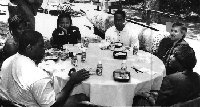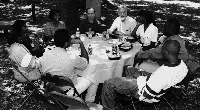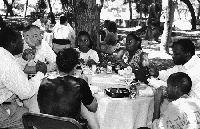SIAM's Stanford Meeting Features Second Focus on Diversity Workshop
January 8, 1998

Richard Tapia joins Mimi Celis (middle) and diversity workshop veteren Cristina Villalobos during the luncheon session. "I was elated to have presented at the workshop," says Villalobos. "My next step is to present at a SIAM Minisymposium."
The second SIAM Graduate Student Focus on Diversity Workshop was held on July 15, 1997, at Stanford University, during SIAM's 45th Anniversary Meeting. (For information on the first workshop, which was coordinated by computational and applied mathematics minority graduate students at Rice University at the request of workshop organizers Richard Tapia and Margaret Wright and held at the 1995 SIAM Annual Meeting in Charlotte, North Carolina, see Cristina Villalobos's article in the December 1995 issue of SIAM News, page 2). Partial support for the 1997 workshop was provided by The Boeing Company, the Department of Energy, NASA, the National Security Agency, and SIAM.

Workshop co-organizer Juan Meza (top right) leads a discussion of career options with (counterclockwise) Steven Lee, Cassandra McZeal, Stacia Wood, Illya Hicks, and Pamela Williams. "Workshops like this one emphasize that we, as minority students, can do quality research," says Hicks. For the students, who gave talks, "the workshop was a chance to present their research to a professional audience.
The workshop included eight well-attended presentations given by postdoctoral researchers and graduate students. "In some of the sessions there was standing room only!" says Juan Meza of Sandia National Laboratories, who with James Curry of the University of Colorado-Boulder organized the Stanford workshop; in some cases, attendance at the workshop sessions surpassed attendance at the meeting's regular sessions.
The eight speakers were Ricardo Cortez, Courant Institute of Mathematical Sciences; Alice Livingston, Arizona State University; Leticia Velazquez, Rice University; Jamylle Carter, UCLA; Douglas Varela, California Institute of Technology; Dawn Lott-Crumpler, University of Maryland-College Park; Rebecca Varela, University of California-Berkeley; Cristina Villalobos, Rice; and Rudy Horne, University of Colorado-Boulder. The topics of their talks included the dynamics of granular materials, image restoration, soliton systems, and the use of interior point methods for solving the phase problem in crystallography.

Jamylle Carter (at right wearing white blouse), who "gained encouragement from other minority grad students and PhDs" at the workshop, exchanges ideas with (counterclockwise) then-SIAM secretary Peter Castro, SIAM president John Guckenheimer, Alice Livingston, Dawn A. Lott-Crumpler, E. Rachelle Harley, William Christian, Jr., Shondarrell Webb, and Jeffrey Livingston.
As at the first workshop, says Meza, special efforts were made to contact undergraduate students from local colleges and universities in the hope that another generation of students would become familiar with SIAM. The 1995 workshop had been created for undergraduates, Villalobos wrote in her 1995 article, and their participation provided both the graduate students who addressed the workshop and the scientists who attended it with renewed excitement about the mathematical sciences.
Participants benefited from the Stanford workshop in similar ways. "When you have the opportunity to attend a conference such as this," says Villalobos (a speaker at the workshop), "you learn that there are many people just like you who are also in graduate school and who are succeeding. You build contacts, keep in touch, advise, mentor, and help out as much as you can. You learn how one person coped with a certain stage in graduate school, and you learn that you are not the only one going through this experience."
"Workshops like this one emphasize that we, as minority students, can do quality research," says Illya Hicks, another student in the computational and applied mathematics program at Rice. For the students who gave talks, he adds, "the workshop was a chance to present their research to a professional audience."
Such opportunities can be real confidence builders. "I left the conference with more self-confidence after giving my first research presentation," explains Villa-lobos. "I found it very comfortable giving it among graduate students and people I knew who cared about the cause of minorities. I was elated to have presented at the workshop; my next step is to present at a SIAM minisymposium.

Making the rounds during the animated lunchtime session, workshop co-organizer James Curry (far left) stops for conversation with (moving counterclockwise) the Turner family---Illona, Everett, and James---and Clarissa Zellars, Mannietea Curry, and Cleve Moler.
"I also learned there are many caring people---professors, administrators, scientists and other students---who are sincere in their work towards helping minority students," she adds. "We need to acknowledge this [support] and take action when we, too, are in a position to help others."
Workshop speaker Jamylle Carter also appreciated the opportunities provided by the workshop. "I gained confidence in my ability to give a good presentation," she explains. "I also gained encouragement from other minority grad students and PhDs. I really needed to see other mathematicians who looked like me, especially black women, and I learned how to discuss my work with other scientists.
"I was surprised that I could give a talk on other people's work," continues Carter. "For my talk, I mainly discussed my field (image processing) and the work that other people had done. I thought that I needed practically a dissertation, full of new results and all. That was unnecessary. This was my first technical presentation, and it was great preparation for my first oral exam."
Opportunities for networking and other interactions, including face-to-face, informal curricular counseling for undergraduates who were considering applying to graduate programs in the mathematical sciences, occurred during the lunch session, reports Meza; several senior SIAM officers and about 20 mathematicians from industry, national laboratories, and various universities participated in the lunch session.
The final session of the workshop, "The Real Deal," allowed for a frank and candid discussion of such topics as graduate school experiences and expectations, career expectations, and the job market for minority postdoctoral researchers and graduate students.
"The rap session at the end of the day was wonderful," says Carter. "We discussed time management, a serious problem for the minority scientist who is always in demand. It was the first time that I had ever been in a room full of black and Latino mathematicians.
"These workshops are crucial for minority grad students," she adds. "Even though I am a good student at a reputable institution, I still had doubts about my ability-whether my work was 'good enough,' whether I was smart enough, etc. It is important that students who have been historically excluded from research universities be actively, visibly supported by the institutions in which they work. I will be the first person in my family to earn a PhD. Three of my four grandparents never completed high school. The entry of minority scholars into the profession is still recent, and we need every effort to maintain the small numbers we have and to increase them."

